
Feature Article
Siu Mei and Food Safety
In June 2023, the Centre for Food Safety (CFS) investigated a series of food poisoning cases involving siu mei. The affected persons presented with gastrointestinal (GI) symptoms including abdominal pain, diarrhoea and vomiting. The incriminated food items were siu mei dishes and the causative agent was suspected to be Salmonella. Hygiene and food handling deficiencies, including preparation of siu mei too far in advance, prolonged storage in the temperature danger zone, inadequate cooking temperatures and cross-contamination with raw food, were detected in the siu mei kitchen in question.
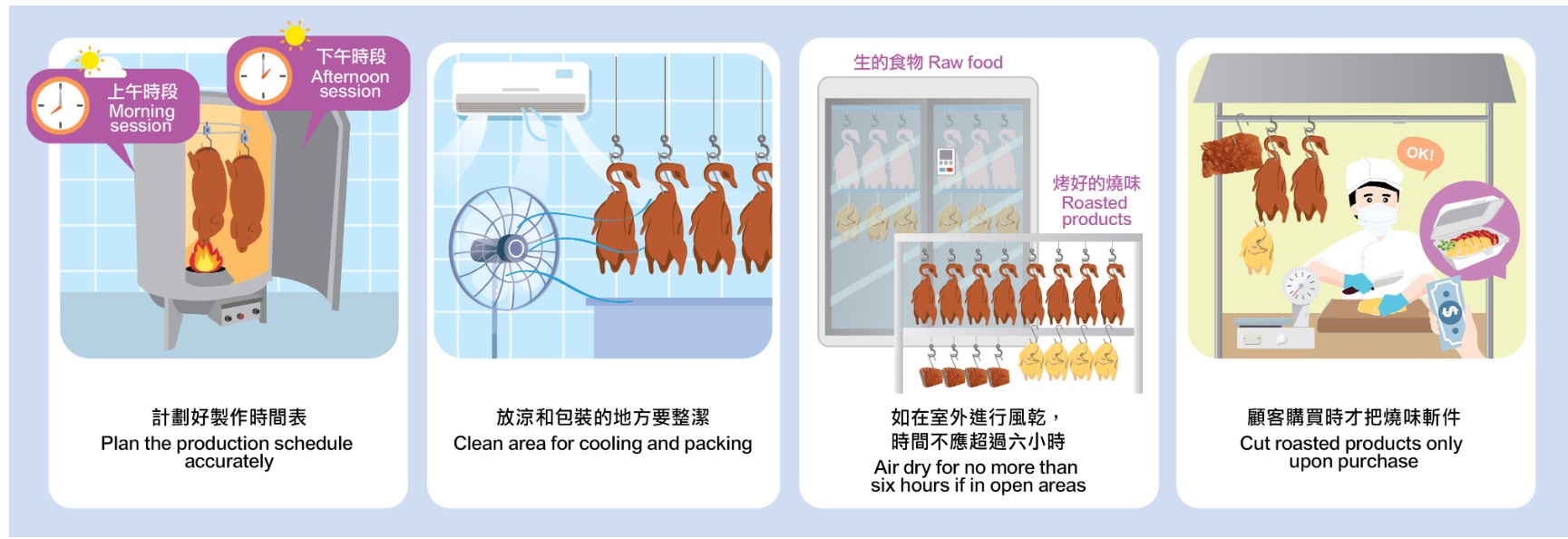
Good practices in preparing and selling siu mei
Common Pathogens in Siu Mei
Salmonella and Staphylococcus aureus were implicated in past siu mei food poisoning outbreaks. Salmonella causes GI illnesses within 6 to 72 hours after oral exposure, with symptoms such as nausea, vomiting, abdominal cramps, diarrhoea, fever and headache. While the infection is usually self-limiting in healthy individuals, it may be lethal to susceptible populations. Salmonella can be found in contaminated water, soil, food contact surfaces and hands, and in the GI tracts of animals and humans. It is spread mainly through the faecal-oral route and contaminated water. The process of slaughtering can also cause contamination of meat.
On the other hand, S.aureus, commonly found in the hairs, skin, nasal cavity, throat and wounds of humans, can contaminate food through food handlers’ hands, especially after cooking. For food involving post-cooking cutting and prolonged storage at room temperature, S.aureus can grow exponentially and form heat-stable toxins.
Antimicrobial Resistance (AMR) Bacteria
AMR bacteria are not necessarily pathogens and can be commensal bacteria that derive benefits from their association with humans. Similar to other environmental organisms or commensal bacteria in humans, AMR bacteria can contaminate food if food and hand hygiene is neglected. Although AMR infections can be asymptomatic, microorganisms can still gain resistance spontaneously by gene mutation or gene transfer among each other. The strategies provided in the “Five Keys to Food Safety” for preventing foodborne diseases can also effectively reduce the risk of AMR infections.
Addressing Food Safety Issues Related to Siu Mei
Although pathogens can be easily killed by thorough cooking, some common malpractices can lead to contamination of siu mei.
-
Unhygienic air drying process, where siu mei can become contaminated due to dirty environment or prolonged drying time;
-
Contamination due to poor protection of siu mei after cooking and during subsequent handling, including display, cutting and transportation;
-
Dirty equipment and poor personal hygiene;
-
Cross-contamination by raw or partially cooked food;
-
Prolonged display of cooked siu mei due to over-production.
Food Safety Measures for Production of Siu Mei
Production
Plan the production schedule accurately ahead of time to avoid over-production and prolonged storage of cooked siu mei at room temperature. Arrange for two or more sessions of roasting daily to cater for the demand during peak hours at lunch and dinner, thereby minimising the storage time. Defrost frozen meat in a refrigerator at 4℃ or below or under running water. Do not defrost the frozen meat at room temperature.
Post-production Handling
Designate a clean area away from raw food for cooling and packing cooked siu mei with dedicated tools to prevent cross-contamination. Keep the area clean. Vehicles for transporting siu mei should not have been previously used for transporting raw food or chemicals to prevent contamination. Cover the siu mei while leaving adequate room to avoid moisture build-up.
Display and Sale
Minimise the display time with accurate production planning. Display siu mei in insect-proof and dust-proof showcases, in which no raw food should be stored. Avoid stacking of siu mei. Follow the “2-hour / 4-hour” rule for display of siu mei at room temperature. Cut roasted siu mei only upon purchase. Roasted products, especially pre-packaged ones, kept in the temperature danger zone should preferably be sold within two hours after chopping.
Key Points to Note:
- Pathogens such as Salmonella and aureus can be present in meat and meat products as many animals harbour them naturally;
- Thorough cooking of food can kill many pathogens and AMR bacteria;
- Proper planning, production and handling of siu mei, as well as maintenance of personal and environmental hygiene can prevent microbiological contamination.
Advice to the Public
- Purchase siu mei at well-maintained licensed premises. Store siu mei properly and consume it as soon as possible.
Mascot ON in Lesson
Securing Food Safety during Adverse Weather and Extreme Conditions
Hong Kong often experiences adverse weather and extreme conditions caused by tropical cyclones and storm surges, which could result in flooding and power outages, especially during summer. While members of the public may stock up on food in preparation for such emergencies, flooding and power outages could expose food to improper storage conditions, causing spoilage and contamination of food. This article discusses the strategy to make preparations for food storage and highlights the steps for securing food safety when facing flooding and power outages.
Plan Wisely and Store Suitable Amount of Food
Some people may consider buying and storing food beyond their need before the advent of adverse weather and extreme conditions. It is essential to store food properly to avoid spoilage and it is preferable to buy only the quantity needed. Before you go shopping for food, keep a running list of meals and their ingredients and reserve sufficient storage capacity. Do not buy food that is near or past its expiry date.
After shopping, keep the food according to storage instructions, for example keep the food refrigerated at ≤4°C or frozen at ≤-18°C. Cooked and perishable foods (for example fresh meat and poultry, aquatic products and milk) should be refrigerated within two hours. To prevent contact between raw food and ready-to-eat or cooked food, they should be stored separately in covered or sealed containers. Do not overload the refrigerator so as to maintain good circulation of cold air. Non-perishable food items should be kept in a cool and dry place.
Salvage Food after Floods – Safe or Not?
All perishable food that has not been refrigerated or frozen properly due to power outages should be discarded. During flooding, food may be immersed in floodwater. Floodwater may contain pathogens and can contaminate food. It is therefore important not to eat any food that has been immersed in floodwater and has not been packaged in a waterproof container. All non-prepackaged food items and those without waterproof packaging that have been immersed in floodwater should be discarded. Only commercially manufactured metal cans with double-seamed lids and retort pouches are regarded as waterproof food packaging. Food with such packaging may be salvageable after thorough washing, sanitising and labelling. Any food with an unusual odour, colour or texture should be thrown away.
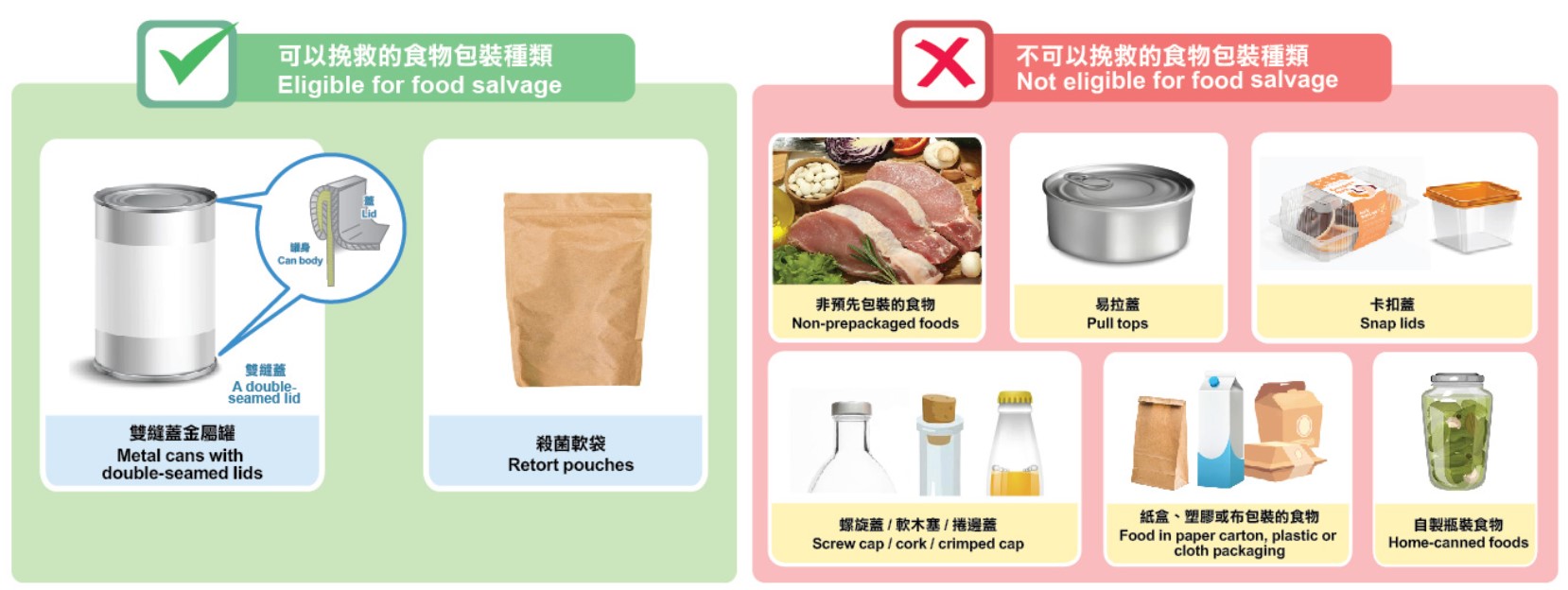
Examples of food items eligible and not eligible for food salvage
How to Wash and Disinfect Utensils after Flooding?
For those containers and dishware made of waterproof materials that may have come into contact with food, they can be reused after thorough washing and sanitising. Take metal pans and ceramic dishes for example. Simply wash them with soap and water and then rinse. Sanitise the cleaned utensils by boiling them in clean water or immersing them in 1:99 diluted household liquid bleach for 15 minutes, and then allow them to air dry. Wooden and plastic utensils like cutting boards should be discarded if they have been immersed in floodwater as they cannot be safely cleaned.
Keeping Food Safe during a Power Outage
Most refrigerators and freezers do not have backup power supply. When electricity is cut off, cold air will stop circulating, which could expose food to unsafe temperatures. Keeping frozen gel packs, ice cubes and dry ice in refrigerators before a power outage can help store food at safe temperatures for a longer period of time. It is advisable to keep a thermometer in the refrigerator to indicate the temperature, which helps determine afterwards whether the foods stored are still safe to eat. When a thermometer is not available, we can still determine whether the foods stored are still safe by keeping track of the downtime. Keeping refrigerator and freezer doors closed can maintain cold temperature. If the doors have not been opened, the food stored will stay safe for 2 to 4 hours in the chiller, 24 hours in a half-full freezer and 48 hours in a full freezer.
When the power returns, check the temperature of the refrigerator and the freezer to see whether perishable foods like fresh meat and poultry have been exposed to the temperature danger zone (i.e. between 4°C and 60°C). For high-risk food that has been kept within the temperature danger zone, follow the “2-hour/4-hour rule”. Some frozen foods may still contain ice crystals, they are safe to be refrozen or cooked. However, ice-cream should be discarded even if it feels cold as if refrigerated. Never taste foods to determine whether they are safe to eat, as they might not give off an abnormal taste or odour even if they are spoiled.
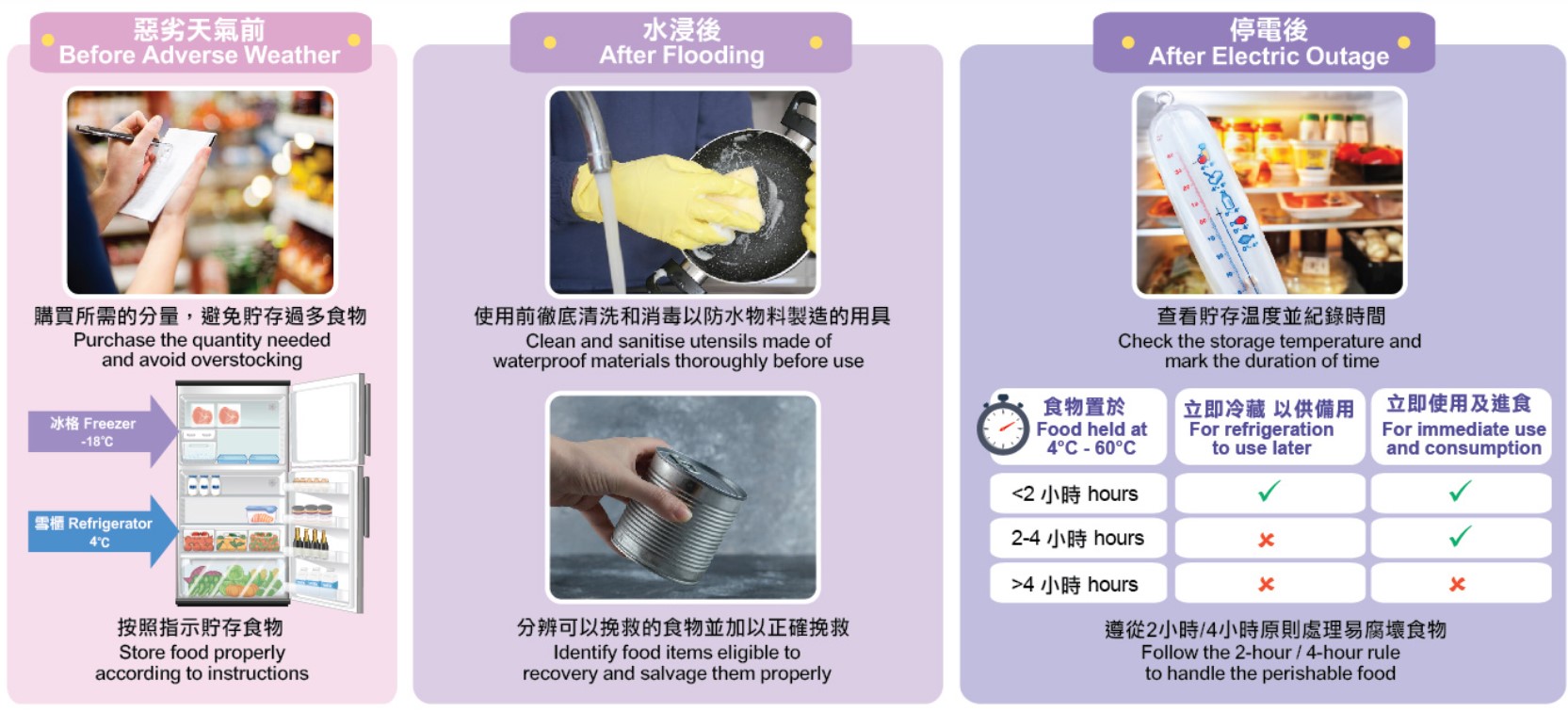
Tips on food safety before the advent of adverse weather and extreme conditions, after flooding and after electric outages
Securing food safety during adverse weather and extreme conditions is essential. In addition to making preparations for food reserve, the trade and the public should be well-prepared for flooding and power outages. Food business operators should ensure that food is fit for human consumption and discard spoiled food. The public should carefully identify food items eligible for recovery and salvage them properly before consumption.
Food Poisoning Caused by Consumption of Wild Taro
In August 2023, a patient received medical treatment at a local hospital for suspected calcium oxalate raphide poisoning after consuming wild taro and developing symptoms including shortness of breath, oral numbness and burning sensation of the mouth.
Taro is a popular food ingredient. However, wild taro may contain needle-shaped calcium oxalate raphide crystals. The raphides cannot be destroyed by washing or cooking and can become dislodged from the plant cells when chewed, causing instant irritation by puncturing the sensitive tissues in the mouth and throat. The rapid onset of symptoms, including pain and swellings, usually limits further intake and hence its effect on the body. Calcium oxalate in other shapes are less likely to cause irritation.
To avoid poisoning, do not pick and eat wild plants, including wild taro. Purchase vegetables from reliable suppliers.
Dining Out
Food Safety Risk of Soft-scrambled Eggs
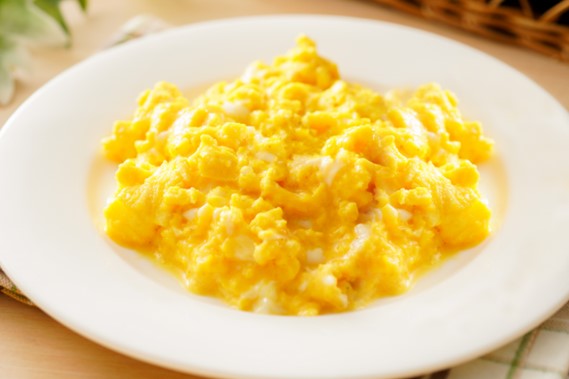
Last July, there was a suspected food poisoning case related to the consumption of soft-scrambled egg dishes. Investigation revealed that the pooled liquid eggs for making the dishes were kept at room temperature and undercooked. Soft-scrambled eggs are often produced by pooled eggs, where pooling allows contaminated eggs to contaminate the whole pool of eggs. To maintain the desirable texture, the eggs may not be thoroughly cooked. Consuming contaminated eggs without adequate heat treatment can lead to food poisoning.
To minimise the risks of contracting foodborne pathogens, egg products should be cooked thoroughly. For dishes not intended to be thoroughly cooked to keep the required texture, choose pasteurised eggs, egg products or dried egg powder. Use all pooled eggs on the same day, refrigerate them if not for immediate use and do not top up with new eggs. If not immediately served, soft-scrambled egg dishes should be kept at a proper holding temperature Note 1. Susceptible populations should not consume high-risk foods including raw or undercooked eggs.
Note 1 For more details, please visit the following webpage:
https://www.cfs.gov.hk/english/multimedia/multimedia_pub/multimedia_pub_fsf_156_01.html

Healthy Eating Basics and Smart Food Choices
Healthy Eating Basics
How to Interpret the Test Report on Chocolate

Chocolate is a popular choice of gifts during festive seasons and occasions. An organisation collected 29 samples of prepackaged chocolate (including dark chocolate and milk chocolate) on the market for food safety and nutrient content tests.
Listen To Our Mascots:
- Food contaminants may originate from natural sources, environmental pollution, or formed during food processing.
- For the levels of contaminants detected as stated in the organisation's report, the risk assessment of the CFS revealed that all chocolate samples met the local legal requirements as they would not be detrimental to health upon normal consumption.
- As for the ten cases concerning nutrition labels referred by the organisation, the CFS found one product suspected of violating relevant labelling regulations, and has instituted prosecution and taken follow-up action. Apart from the four products no longer available for sale on the market, the remaining products concerned were tested by the CFS. The test results of three of them were satisfactory, while those of the others have yet to be confirmed.
- From 2020 to mid-2023, the CFS collected a total of around 500 chocolate samples for chemical (including metallic contaminants and the nutrition content) and microbiological tests. Among them, five samples failed the nutrition content test, while all the remaining samples passed the tests.
A Reminder On Food Safety:
- Chocolate in general is high in fat and sugar content, and excessive consumption is not advisable. Members of the public should read the nutrition labels and choose products with relatively low fat and sugar content.
Smart Food Choices
Vegetable Soup with Wood Ear Fungus and Chinese Wolfberries
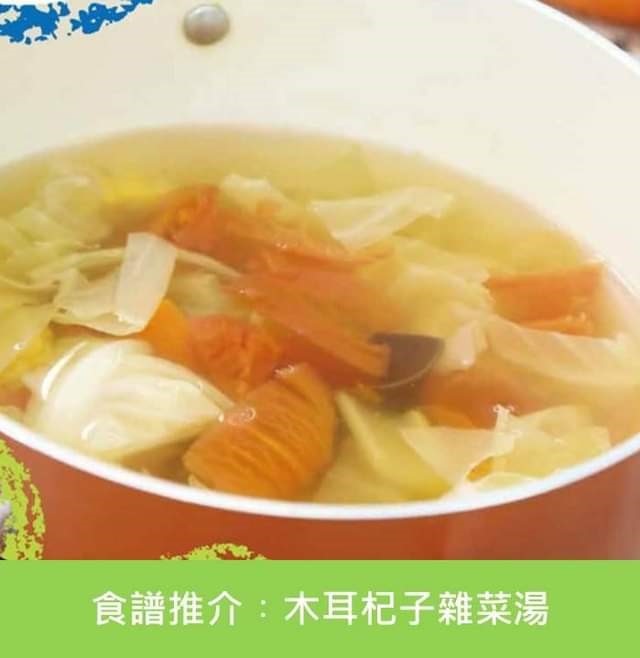
- Whether a soup is tasty or not depends on the ratio of ingredients and water. If you have chosen the right ingredients, just a little bit of salt is enough to bring out a rich flavour.
- If you are unsure about how much salt to add to a soup, you might as well take a look at this recommended recipe: vegetable soup with wood ear fungus and Chinese wolfberries (one serving, with approximately 327 mg of sodium).
*Note: When drinking soup, be mindful of the amount of consumption. Over-consumption is likely to cause excessive intake of salt, which is detrimental to your health.
For more information, please refer to the “EatSmart Restaurant Star+” website of the Department of Health (DH):
https://restaurant.eatsmart.gov.hk/eng/content.aspx?content_id=755

News on CFS
1. CFS's Press Briefing for Announcing Risk Assessment Study Results on Industrially Produced Trans Fatty Acids Content in Prepackaged and Non-Prepackaged Food
The CFS announced on 9 November 2023 the results of a risk assessment study on industrially produced trans fatty acids (IP-TFA) content in prepackaged and non-prepackaged food. The CFS collected 149 samples from five food categories, namely fats and oils, margarines and spreads, prepackaged foods, ready-to-eat foods and miscellaneous local specialities for IP-TFA content analysis. Results revealed that the levels of IP-TFA in 143 out of the 149 samples were below the World Health Organization (WHO) guidance level of 2 grams per 100 grams total fat, while six samples contained IP-TFA higher than the WHO guidance level.
For details of the study report, please visit the following webpage or scan the relevant QR code:
https://www.cfs.gov.hk/english/programme/programme_rafs/programme_rafs_n_01_32_IpTFA_Content_in_Prepackaged_and_Non_prepackaged_Food.html



The press briefing is hosted by Dr. Sze Kwan Lok, Chemist (Risk Assessment) (left), Dr. Cheung Yung Yan, Consultant (Community Medicine) (Risk Assessment & Communication) (middle) and Mr. Hung Chi Tat, Senior Chemist (Risk Assessment) (right).
2. Talk on the Daya Bay Contingency Plan Held by CFS
The CFS jointly organised an annual talk on the Daya Bay Contingency Plan with relevant government departments (including the DH, the Electrical and Mechanical Services Department and the Food and Environmental Hygiene Department (FEHD)) on 23 November 2023. On the day of the talk, departmental representatives took turns to share on topics relating to their respective scope of work, such as nuclear power generation, radiation monitoring, radiation exposure pathways, surveillance of imported food, management of contaminants and wastes, radiation devices, and protective equipment monitoring, so as to update our colleagues on the contingency plan.
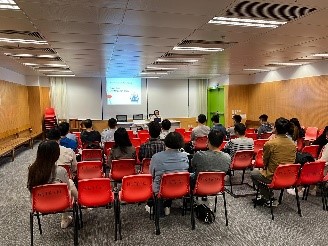
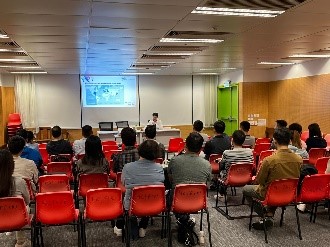
3. Briefing for Students of Bachelor Programmes, Chinese University of Hong Kong (CUHK)
Like previous years, the CFS held a briefing for students of Bachelor of Science in Community Health Practice and Public Health programmes, Faculty of Medicine, CUHK on 4 December 2023 to give information on the role of the FEHD in food safety surveillance and control in Hong Kong so that the students can have a preliminary understanding of the work of the CFS, thereby facilitating their career planning for professional development.
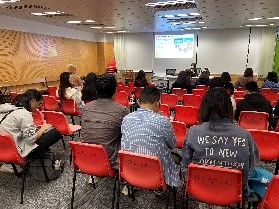
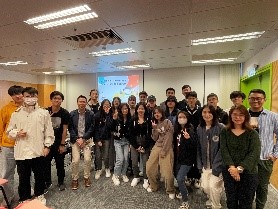
4. Food Safety Seminar for Trade 2023 Held by CFS
On 7 December 2023, the CFS held the Food Safety Seminar for Trade 2023, which aimed to provide an opportunity for the Government and food trade to exchange information and views on current and important food safety issues in Hong Kong, and encourage continuous improvement and collaboration in securing food safety among the local food trade.
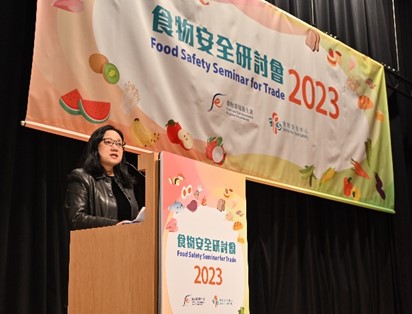
Dr. Wong Wang, Controller, CFS officiates and delivers an opening address at the Food Safety Seminar for Trade 2023.

The seminar, held at Charles K. Kao Auditorium, Hong Kong Science Park, consisted of four sessions, namely Expert Sharing, Control Measures and System Implementation, Legislation and Guidelines, and Producing Safe and Healthy Food & Food Safety Promotion. The seminar was divided into the morning and the afternoon parts, with question and answer sessions for the trade representatives to ask questions.
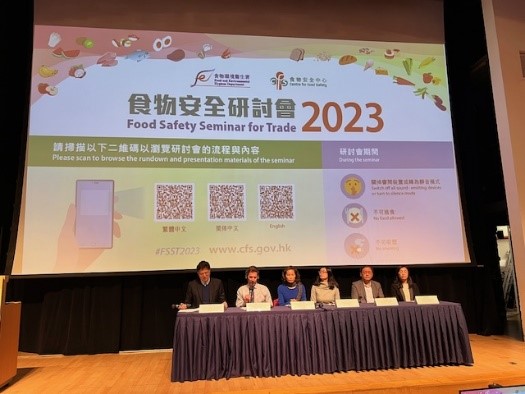

For details of the event, please visit:
https://www.cfs.gov.hk/english/whatsnew/whatsnew_act/Food_Safety_Seminar_for_Trade_2023.html

5. The 83rd Meeting of the Trade Consultation Forum
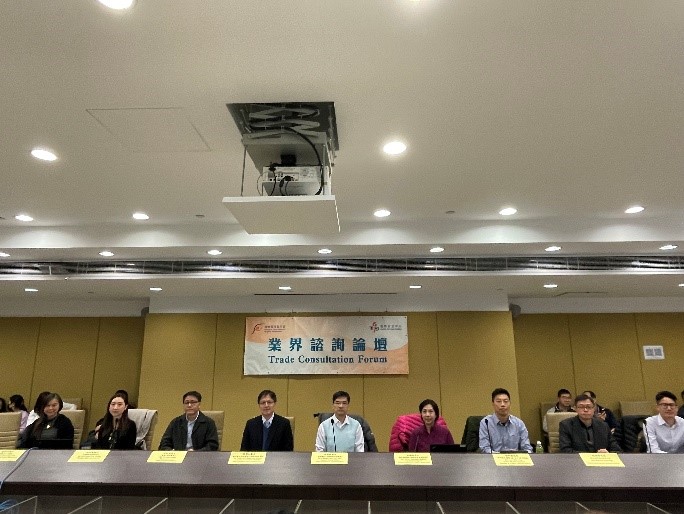
The 83rd meeting of the Trade Consultation Forum was held on 20 December 2023. The CFS and the trade exchanged their views on various topics including “Food Safety Advice for Handling Ready-to-eat Food”, “Risk Assessment (RA) Study on IP-TFA Content in Prepackaged and Non-Prepackaged Food”, “RA Study on Partially Hydrogenated Oils (PHOs) in Food”, “RA Study on Sodium Content in Chinese Congee”, “Further Advice for Food Traders on Importing Japanese Food”, and “Fee Adjustment for Food Inspection Certificate and Health Certificate for Foods of Animal Origin”. For details of the event, please visit:
https://www.cfs.gov.hk/english/committee/Notes_and_Presentation_Materials_TCF83_20231220.html

6. Promotion of Food Safety by CFS at the 57th Hong Kong Brands and Products Expo
The annual Hong Kong Brands and Products Expo is one of the major outdoor trade fairs in Hong Kong. The 57th Expo was held at Victoria Park starting from late December 2023. Same as previous years, the CFS joined the Expo to disseminate food safety messages to the public. For two consecutive days on 3 and 4 January 2024, the CFS set up a booth in the Expo to distribute publicity leaflets, pamphlets and souvenirs to visitors to promote food safety. The booth was bustling with visitors.
Ask Our Mascots
Soufflé Pancakes and Salmonella
In mid-August last year, the CFS conducted an investigation of suspected food poisoning cases related to the consumption of soufflé pancakes from a local restaurant. The investigation revealed the causative pathogen was likely Salmonella. The investigation also found irregularities in the preparation process of soufflé pancakes, namely improper storage temperature of pooled eggs, baking temperature of the soufflé pancakes not properly monitored and the use of unpasteurised whole shell eggs.
Potential Risk of Consuming Undercooked Egg Dishes
Eggs can be contaminated by Salmonella during their formation. If they are stored improperly, Salmonella will proliferate. Salmonella can also survive in undercooked foods, which pose a very high risk of food safety as inadequate heat treatment cannot eliminate pathogens completely and may cause food poisoning upon consumption. Besides Salmonella, undercooked egg dishes may also contain bacteria with antimicrobial resistance (AMR).
How to Store Egg Ingredients and Prepare Soufflé Pancakes Safely?
Field investigation by the CFS found that the storage temperature of raw pooled eggs in the restaurant concerned was above 10°C, which was within the temperature danger zone (i.e. between 4°C and 60°C). Storing food at temperatures within the temperature danger zone allows various types of bacteria to grow rapidly. Dried egg powder, once opened, should be stored in airtight containers placed in a cool and dry place. Refrigerators should include temperature displays, which should be constantly monitored and reported at least twice a day. If any deviations higher than 1°C are identified, checking of the devices is warranted. In addition, following the first-in-first-out (FIFO) principle for the use of egg ingredients is essential to keeping egg dishes safe. Unused egg products in the refrigerator should be stored in covered containers separately to avoid cross-contamination.
Lack of proper monitoring of the baking temperature of soufflé pancakes may explain the survival of harmful pathogens like Salmonella in this case. To prevent food poisoning, it is advisable to cook egg dishes thoroughly until the core temperature reaches 75°C or above, or the whole egg products are firm. Prolonged storage of cooked egg products at room temperature is also a common cause of food poisoning. Therefore, it is important to store hot dishes at above 60°C and cold dishes at 4°C or below, and plan ahead to avoid preparing them too far in advance.
Use Pasteurised Egg Products Wisely
Choosing safe egg ingredients is the crucial step to ensure food safety. Pasteurised shell or liquid eggs are recommended as the pasteurisation process involves heating eggs to a specific temperature for a set time, aiming to prevent spoilage and extend their shelf-life. It can reduce the risk of foodborne illness, especially when preparing egg dishes that are not intended to be cooked thoroughly for achieving the required texture. The occurrence of recent food poisoning cases related to egg products clearly illustrates the risk of using unpasteurised whole shell eggs for preparing these types of egg dishes. If pasteurised egg products are to be used later, store them in sealed containers in the refrigerator and only take out the amount required. Use all of them on the same day and do not top up with new batches of pasteurised egg products.
Key Points to Note:
- Undercooked egg dishes may contain pathogens like Salmonella and AMR strains that could lead to food poisoning and AMR transmission respectively upon consumption.
- Store egg ingredients properly and bake egg dishes thoroughly.
- Use pasteurised egg ingredients to prepare egg dishes that are not intended to be cooked thoroughly, and observe Good Hygiene Practices (GHPs).
Advice to the Public
- Purchase egg products from reliable shops and consume them promptly.
- Susceptible populations such as pregnant women, infants, young children, the elderly and people with weakened immunity should avoid eating raw or undercooked dishes.
Food Safety Quiz
- Which of the following will lead to contamination of siu mei?
- Unhygienic air-drying process, i.e. dirty environment or prolonged drying time
- Poor protection of siu mei after cooking and during subsequent handling, including display, cutting and transportation
- Cross-contamination by raw or partially-cooked food
- Prolonged display of cooked siu mei due to over-production
- All of the above
- Which of the following types of food can be salvaged after being immersed in floodwater?
- Non-prepackaged food
- Food without waterproof packaging
- Food that has not been packaged in waterproof containers
- Food packed in commercially manufactured metal cans with double-seamed lids
- Which pathogen can contaminate eggs during egg formation?
- Sapovirus
- Ciguatoxin
- Salmonella
- Norovirus
Answers:

Diary of Mascot ON
Poisonous Mushrooms

“Don't pick wild mushrooms!” We've said it time and time again. They are highly poisonous. Don't ever take the risk!
Don't Pick Wild Plants during Hiking
Many people go hiking during the Chung Yeung holiday, and some hikers cannot resist the temptation to pick wild plants, such as mushrooms or taro, along the way for food. This may lead to poisoning, causing permanent damage to the organs or even death in serious cases.
Hard to Distinguish between Poisonous and Nonpoisonous Plants
You must think that the brighter the colour a plant has, the more poisonous it is. In fact, you cannot tell whether a plant is poisonous or not by its appearance and sometimes even experts find it difficult to tell. To play safe, don’t touch or eat any wild plants during hiking and buy food from reliable suppliers after you head back down!
Mascot ON says:
Wild mushrooms may contain different kinds of toxic substances like amatoxins, muscarine or gastrointestinal toxin, which can cause abdominal pain, vomiting, convulsions or even death; while wild taro may contain needle-shaped calcium oxalate raphide crystals, which may cause numbness of the tongue and swollen lips.
More information about poisonous plants:
